FORD F750 2012 12.G Owners Manual
Manufacturer: FORD, Model Year: 2012, Model line: F750, Model: FORD F750 2012 12.GPages: 306, PDF Size: 1.74 MB
Page 121 of 306

EXHAUST BRAKE (IF EQUIPPED)
An exhaust brake is an auxiliary braking system that assists, but does
not replace, the primary service brake system. It is intended to help
control vehicle speed; it is not a vehicle stopping device.
A switch on the instrument panel, in
combination with the accelerator
and clutch pedal, allows the
operator to make maximum use of
the exhaust brake in the following
conditions:
•off-highway driving
•mountain driving
•heavy traffic
•high speed highway driving
To operate the brake, push the switch up to turn it on. Push the switch
down to turn it off.
Note:Before starting the engine, make sure that the exhaust brake
switch is pushed down to the off position. Do not turn the exhaust brake
on until the engine has reached normal operating temperature.
While approaching a steep grade, make sure that the exhaust brake
switch is in the on position. The exhaust brake actuates as soon as you
remove your foot from the accelerator pedal.
Before descending a hill or steep grade always select the proper gear. If
the transmission is taken out of gear while descending, it is possible that
you can’t select another gear because of maximum RPM being governed.
Make sure the engine speed does not exceed the maximum allowable
engine RPM; exceeding the maximum allowable engine RPM can result in
damage to the engine. Apply the service brakes to reduce the engine
RPM or make a slower descent by using a lower gear.
While going down the grade, use a low enough gear to descend safely
with a minimum application of the service brakes. As a general guideline,
use the same gear as you use to ascend the hill.
Note:Engine speed has a major influence of retarding performance.
When engine speed is maintained at the maximum allowable level, the
exhaust brake operates at peak performance.
Note:Maximum exhaust brake performance is related to the type of
transmission your vehicle is equipped with.
Driving
121
2012 F-650/750(f67)
Supplement, 2nd Printing
USA(fus)
Page 122 of 306
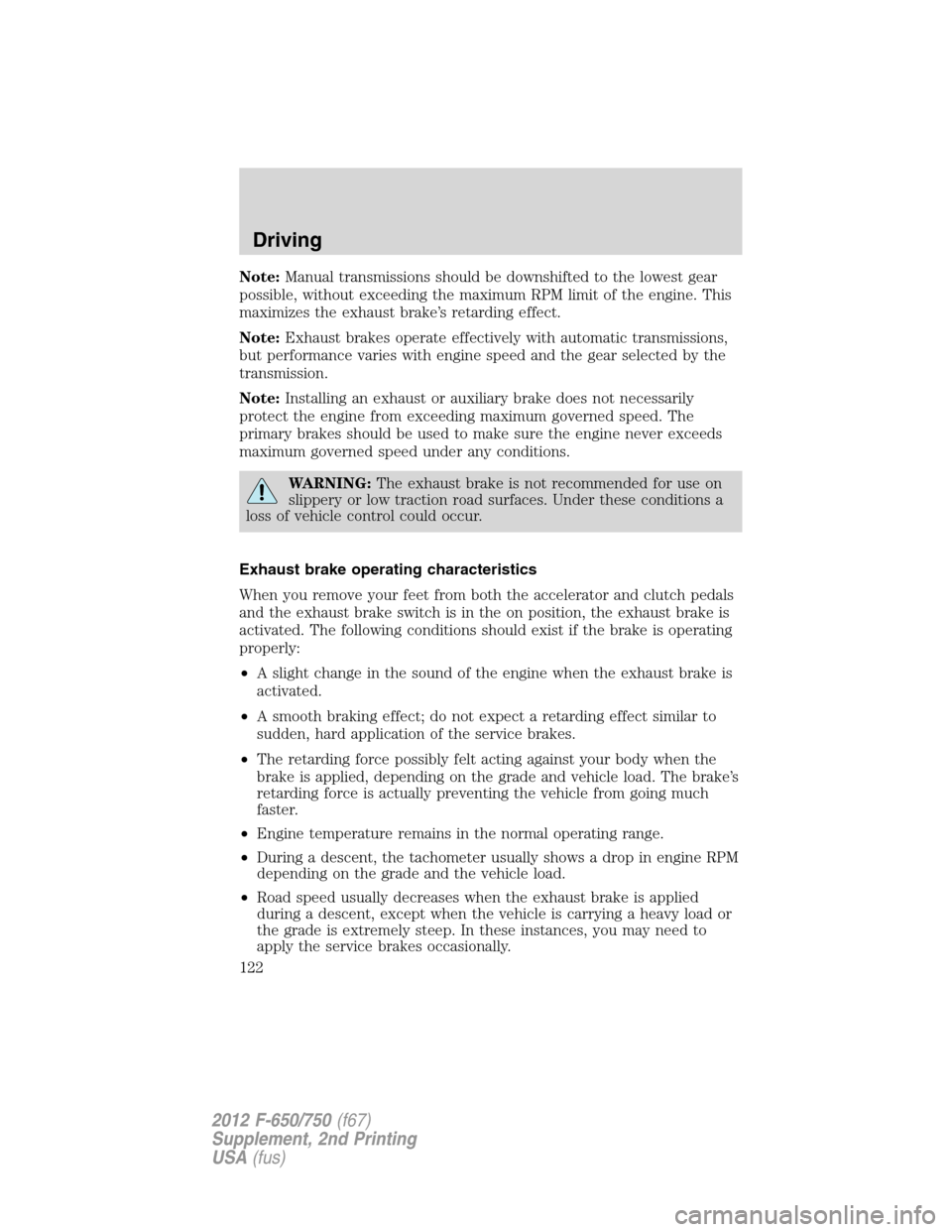
Note:Manual transmissions should be downshifted to the lowest gear
possible, without exceeding the maximum RPM limit of the engine. This
maximizes the exhaust brake’s retarding effect.
Note:Exhaust brakes operate effectively with automatic transmissions,
but performance varies with engine speed and the gear selected by the
transmission.
Note:Installing an exhaust or auxiliary brake does not necessarily
protect the engine from exceeding maximum governed speed. The
primary brakes should be used to make sure the engine never exceeds
maximum governed speed under any conditions.
WARNING:The exhaust brake is not recommended for use on
slippery or low traction road surfaces. Under these conditions a
loss of vehicle control could occur.
Exhaust brake operating characteristics
When you remove your feet from both the accelerator and clutch pedals
and the exhaust brake switch is in the on position, the exhaust brake is
activated. The following conditions should exist if the brake is operating
properly:
•A slight change in the sound of the engine when the exhaust brake is
activated.
•A smooth braking effect; do not expect a retarding effect similar to
sudden, hard application of the service brakes.
•The retarding force possibly felt acting against your body when the
brake is applied, depending on the grade and vehicle load. The brake’s
retarding force is actually preventing the vehicle from going much
faster.
•Engine temperature remains in the normal operating range.
•During a descent, the tachometer usually shows a drop in engine RPM
depending on the grade and the vehicle load.
•Road speed usually decreases when the exhaust brake is applied
during a descent, except when the vehicle is carrying a heavy load or
the grade is extremely steep. In these instances, you may need to
apply the service brakes occasionally.
Driving
122
2012 F-650/750(f67)
Supplement, 2nd Printing
USA(fus)
Page 123 of 306
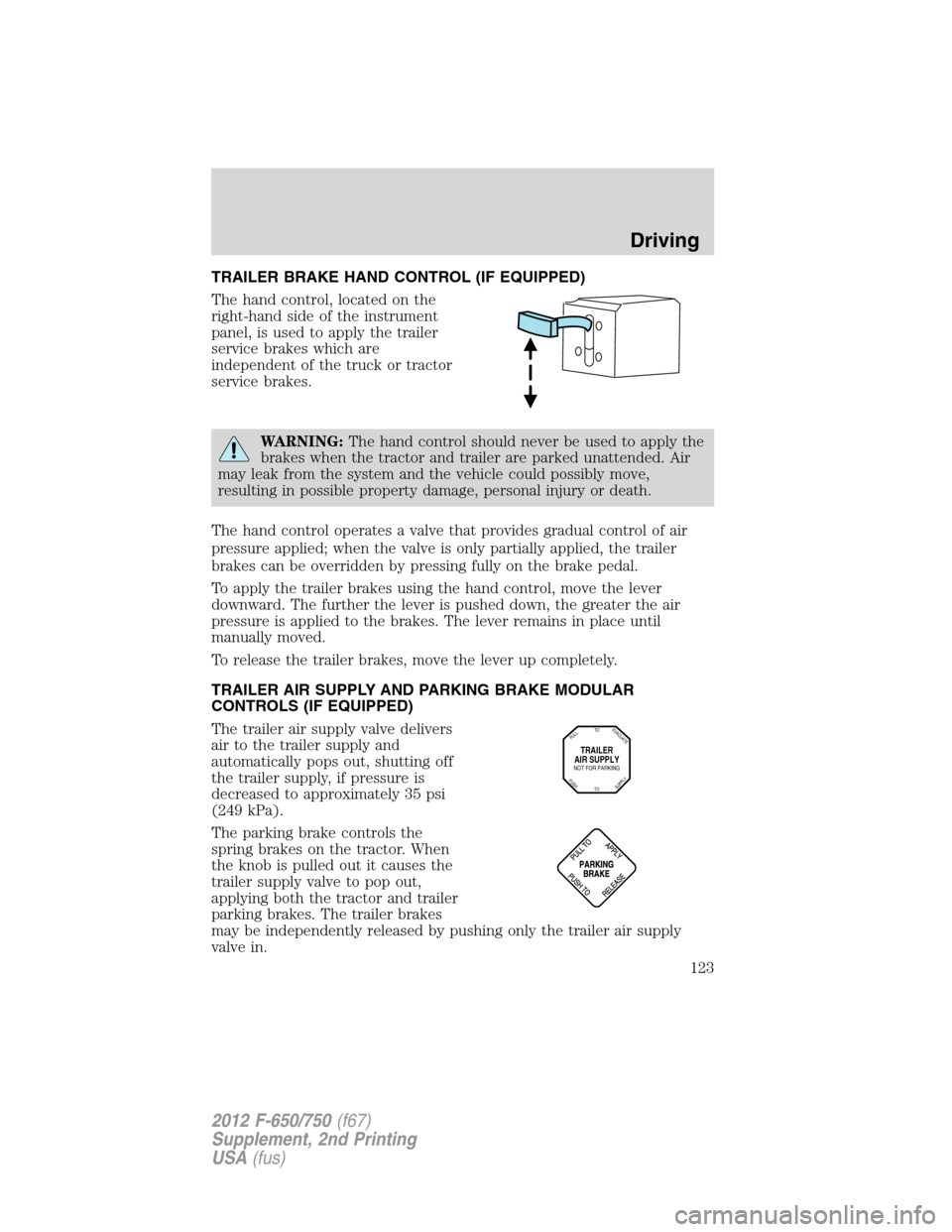
TRAILER BRAKE HAND CONTROL (IF EQUIPPED)
The hand control, located on the
right-hand side of the instrument
panel, is used to apply the trailer
service brakes which are
independent of the truck or tractor
service brakes.
WARNING:The hand control should never be used to apply the
brakes when the tractor and trailer are parked unattended. Air
may leak from the system and the vehicle could possibly move,
resulting in possible property damage, personal injury or death.
The hand control operates a valve that provides gradual control of air
pressure applied; when the valve is only partially applied, the trailer
brakes can be overridden by pressing fully on the brake pedal.
To apply the trailer brakes using the hand control, move the lever
downward. The further the lever is pushed down, the greater the air
pressure is applied to the brakes. The lever remains in place until
manually moved.
To release the trailer brakes, move the lever up completely.
TRAILER AIR SUPPLY AND PARKING BRAKE MODULAR
CONTROLS (IF EQUIPPED)
The trailer air supply valve delivers
air to the trailer supply and
automatically pops out, shutting off
the trailer supply, if pressure is
decreased to approximately 35 psi
(249 kPa).
The parking brake controls the
spring brakes on the tractor. When
the knob is pulled out it causes the
trailer supply valve to pop out,
applying both the tractor and trailer
parking brakes. The trailer brakes
may be independently released by pushing only the trailer air supply
valve in.
TRAILER
AIR SUPPLY
NOT FOR PARKING
TO
TOPULL
SUPPLY
EVACUATE
PUSH
Driving
123
2012 F-650/750(f67)
Supplement, 2nd Printing
USA(fus)
Page 124 of 306
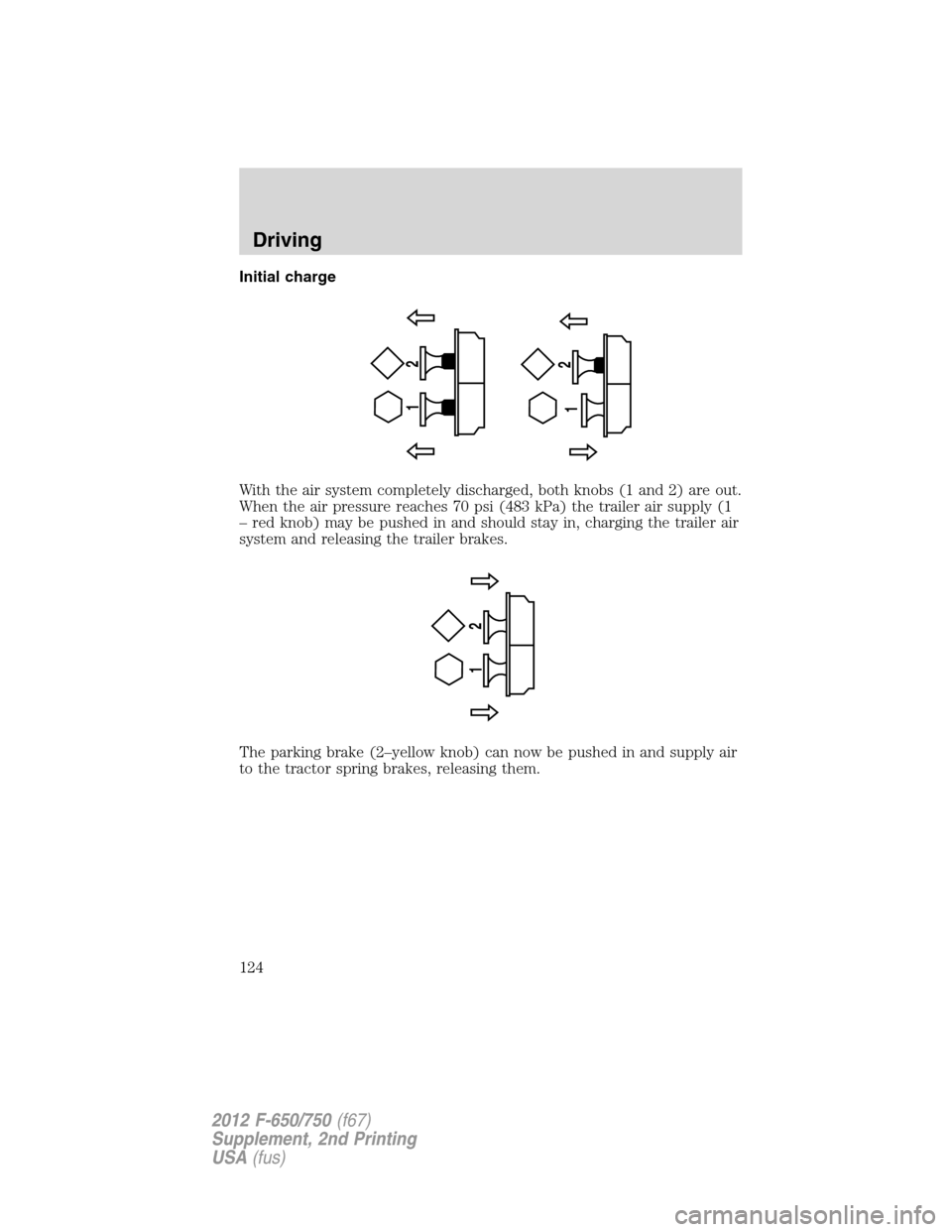
Initial charge
With the air system completely discharged, both knobs (1 and 2) are out.
When the air pressure reaches 70 psi (483 kPa) the trailer air supply (1
– red knob) may be pushed in and should stay in, charging the trailer air
system and releasing the trailer brakes.
The parking brake (2–yellow knob) can now be pushed in and supply air
to the tractor spring brakes, releasing them.
12 12
12
Driving
124
2012 F-650/750(f67)
Supplement, 2nd Printing
USA(fus)
Page 125 of 306
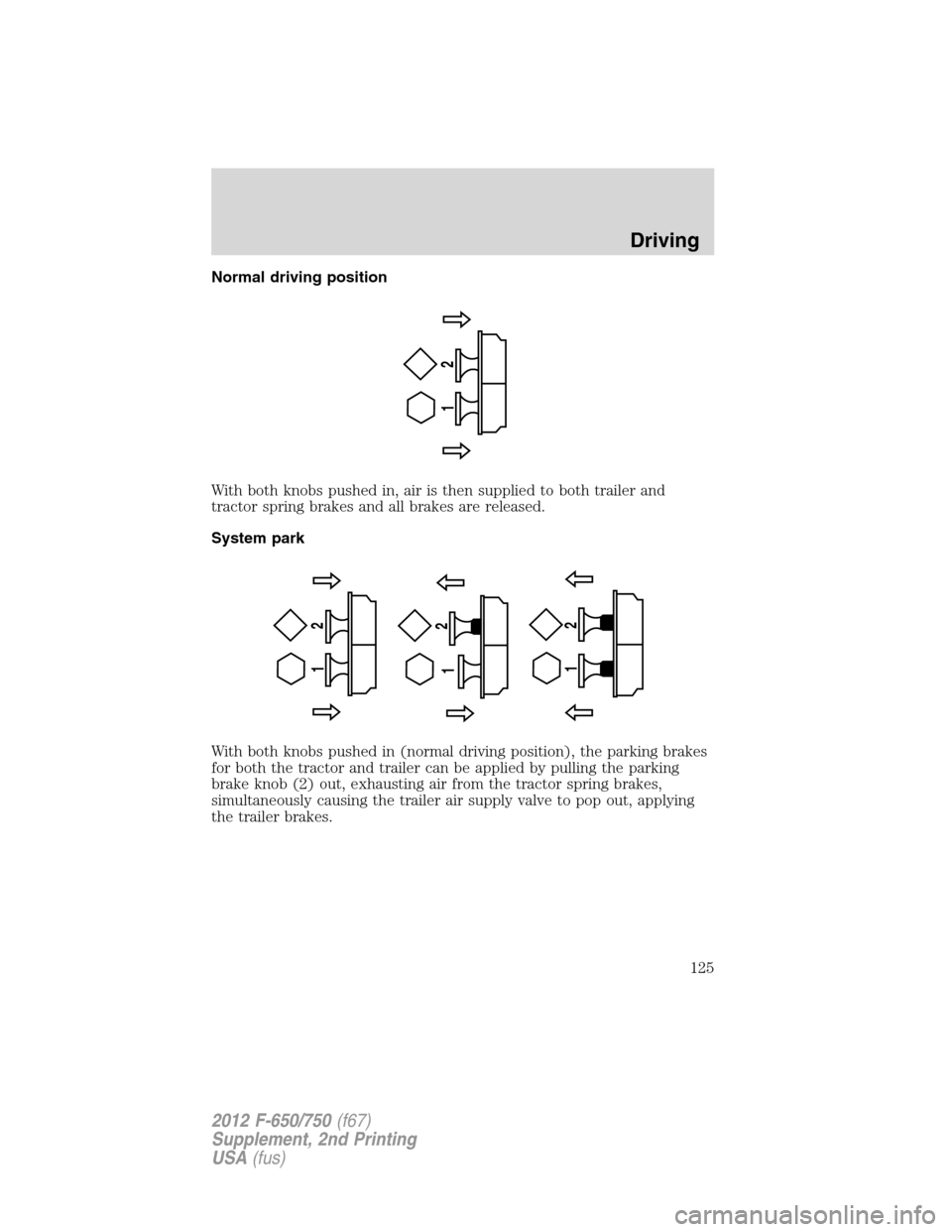
Normal driving position
With both knobs pushed in, air is then supplied to both trailer and
tractor spring brakes and all brakes are released.
System park
With both knobs pushed in (normal driving position), the parking brakes
for both the tractor and trailer can be applied by pulling the parking
brake knob (2) out, exhausting air from the tractor spring brakes,
simultaneously causing the trailer air supply valve to pop out, applying
the trailer brakes.
12
12
12
12
Driving
125
2012 F-650/750(f67)
Supplement, 2nd Printing
USA(fus)
Page 126 of 306
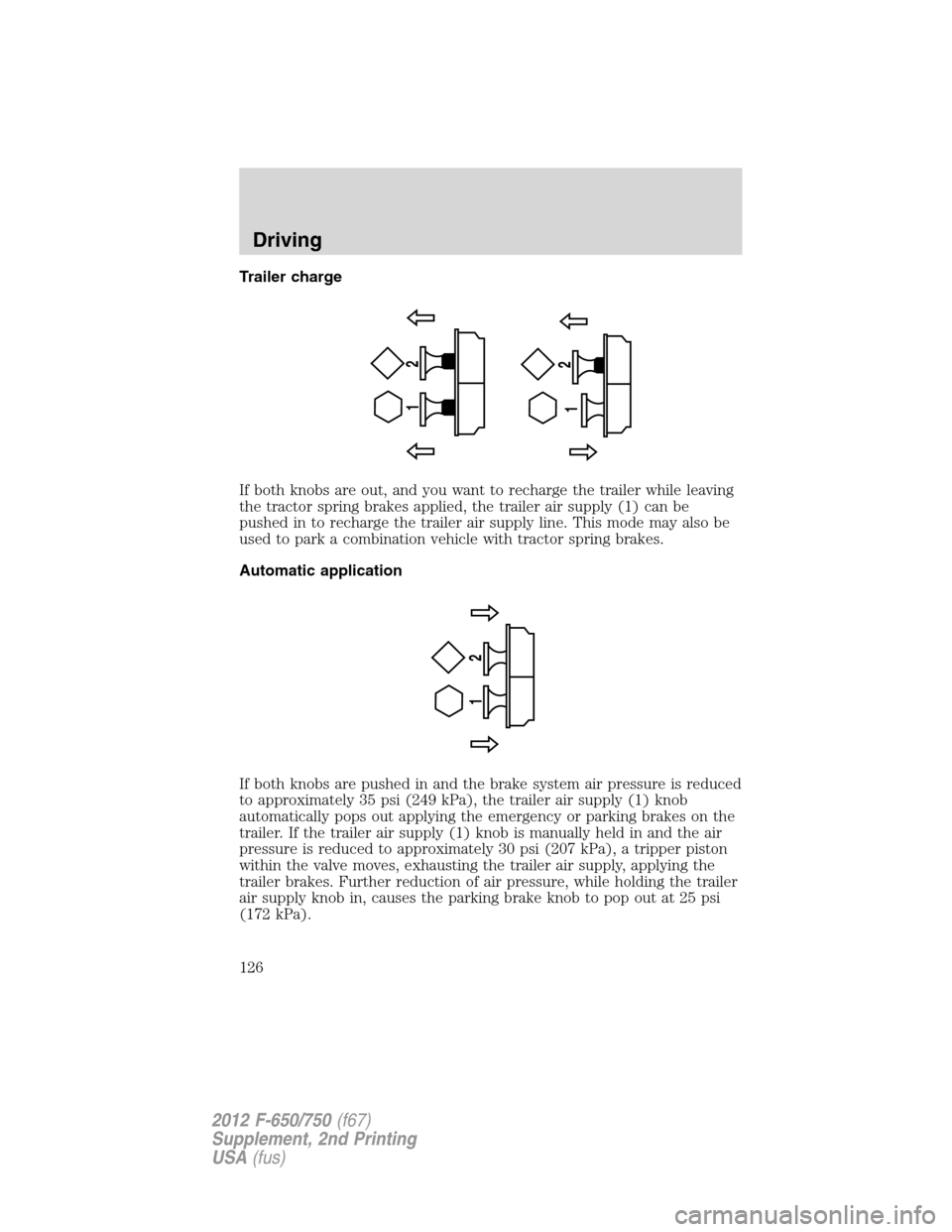
Trailer charge
If both knobs are out, and you want to recharge the trailer while leaving
the tractor spring brakes applied, the trailer air supply (1) can be
pushed in to recharge the trailer air supply line. This mode may also be
used to park a combination vehicle with tractor spring brakes.
Automatic application
If both knobs are pushed in and the brake system air pressure is reduced
to approximately 35 psi (249 kPa), the trailer air supply (1) knob
automatically pops out applying the emergency or parking brakes on the
trailer. If the trailer air supply (1) knob is manually held in and the air
pressure is reduced to approximately 30 psi (207 kPa), a tripper piston
within the valve moves, exhausting the trailer air supply, applying the
trailer brakes. Further reduction of air pressure, while holding the trailer
air supply knob in, causes the parking brake knob to pop out at 25 psi
(172 kPa).
12 12
12
Driving
126
2012 F-650/750(f67)
Supplement, 2nd Printing
USA(fus)
Page 127 of 306
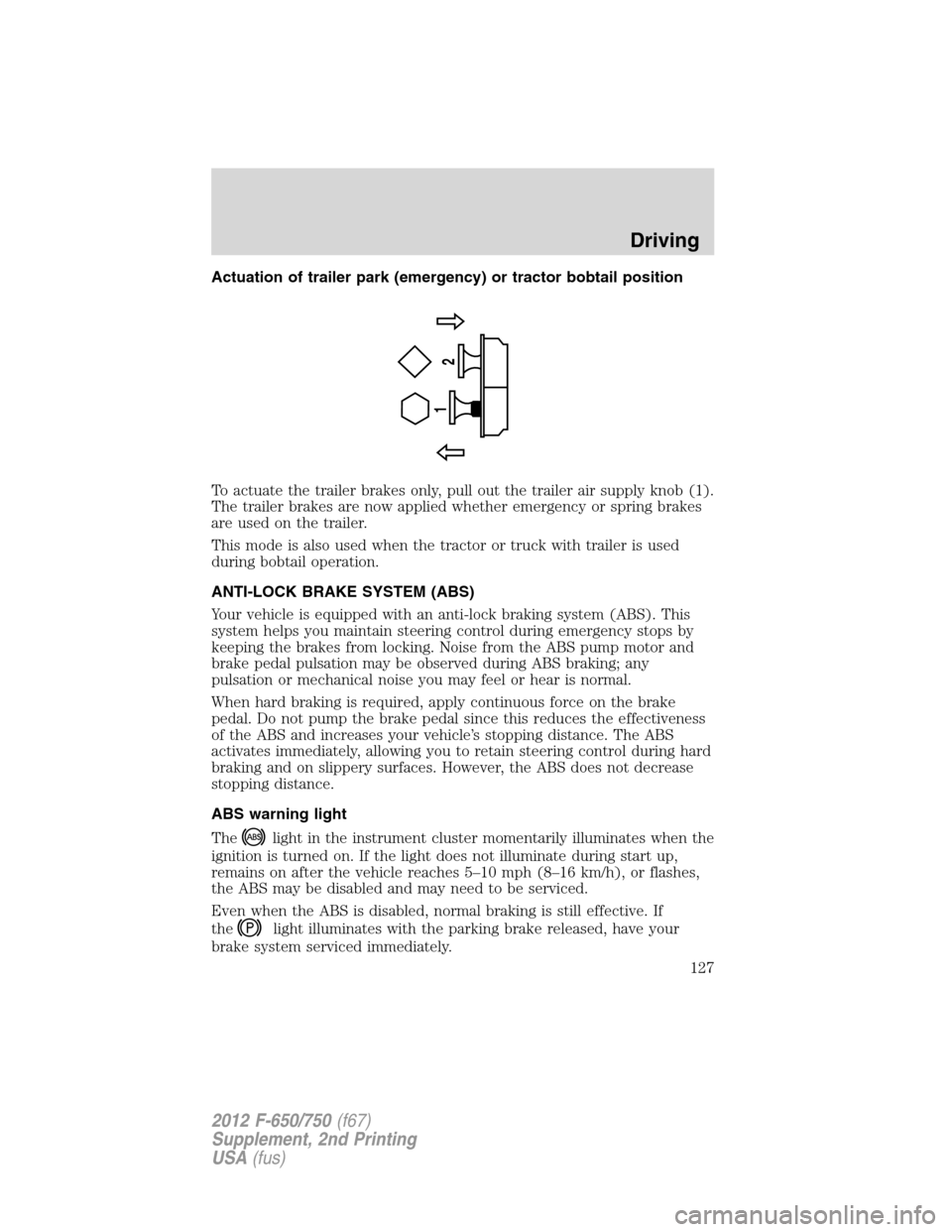
Actuation of trailer park (emergency) or tractor bobtail position
To actuate the trailer brakes only, pull out the trailer air supply knob (1).
The trailer brakes are now applied whether emergency or spring brakes
are used on the trailer.
This mode is also used when the tractor or truck with trailer is used
during bobtail operation.
ANTI-LOCK BRAKE SYSTEM (ABS)
Your vehicle is equipped with an anti-lock braking system (ABS). This
system helps you maintain steering control during emergency stops by
keeping the brakes from locking. Noise from the ABS pump motor and
brake pedal pulsation may be observed during ABS braking; any
pulsation or mechanical noise you may feel or hear is normal.
When hard braking is required, apply continuous force on the brake
pedal. Do not pump the brake pedal since this reduces the effectiveness
of the ABS and increases your vehicle’s stopping distance. The ABS
activates immediately, allowing you to retain steering control during hard
braking and on slippery surfaces. However, the ABS does not decrease
stopping distance.
ABS warning light
The
light in the instrument cluster momentarily illuminates when the
ignition is turned on. If the light does not illuminate during start up,
remains on after the vehicle reaches 5–10 mph (8–16 km/h), or flashes,
the ABS may be disabled and may need to be serviced.
Even when the ABS is disabled, normal braking is still effective. If
the
light illuminates with the parking brake released, have your
brake system serviced immediately.
1
2
Driving
127
2012 F-650/750(f67)
Supplement, 2nd Printing
USA(fus)
Page 128 of 306
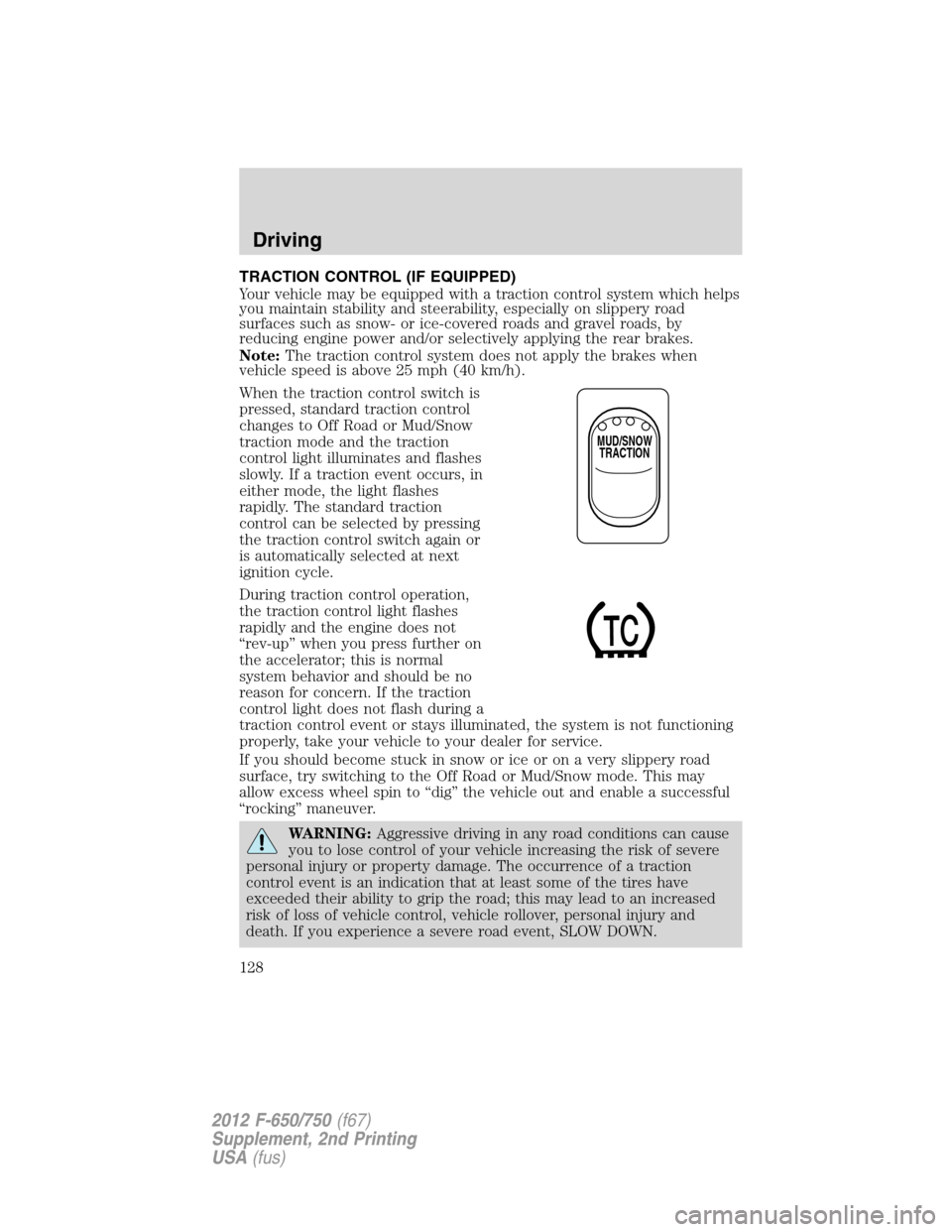
TRACTION CONTROL (IF EQUIPPED)
Your vehicle may be equipped with a traction control system which helps
you maintain stability and steerability, especially on slippery road
surfaces such as snow- or ice-covered roads and gravel roads, by
reducing engine power and/or selectively applying the rear brakes.
Note:The traction control system does not apply the brakes when
vehicle speed is above 25 mph (40 km/h).
When the traction control switch is
pressed, standard traction control
changes to Off Road or Mud/Snow
traction mode and the traction
control light illuminates and flashes
slowly. If a traction event occurs, in
either mode, the light flashes
rapidly. The standard traction
control can be selected by pressing
the traction control switch again or
is automatically selected at next
ignition cycle.
During traction control operation,
the traction control light flashes
rapidly and the engine does not
“rev-up” when you press further on
the accelerator; this is normal
system behavior and should be no
reason for concern. If the traction
control light does not flash during a
traction control event or stays illuminated, the system is not functioning
properly, take your vehicle to your dealer for service.
If you should become stuck in snow or ice or on a very slippery road
surface, try switching to the Off Road or Mud/Snow mode. This may
allow excess wheel spin to “dig” the vehicle out and enable a successful
“rocking” maneuver.
WARNING:Aggressive driving in any road conditions can cause
you to lose control of your vehicle increasing the risk of severe
personal injury or property damage. The occurrence of a traction
control event is an indication that at least some of the tires have
exceeded their ability to grip the road; this may lead to an increased
risk of loss of vehicle control, vehicle rollover, personal injury and
death. If you experience a severe road event, SLOW DOWN.
MUD/SNOW
TRACTION
Driving
128
2012 F-650/750(f67)
Supplement, 2nd Printing
USA(fus)
Page 129 of 306
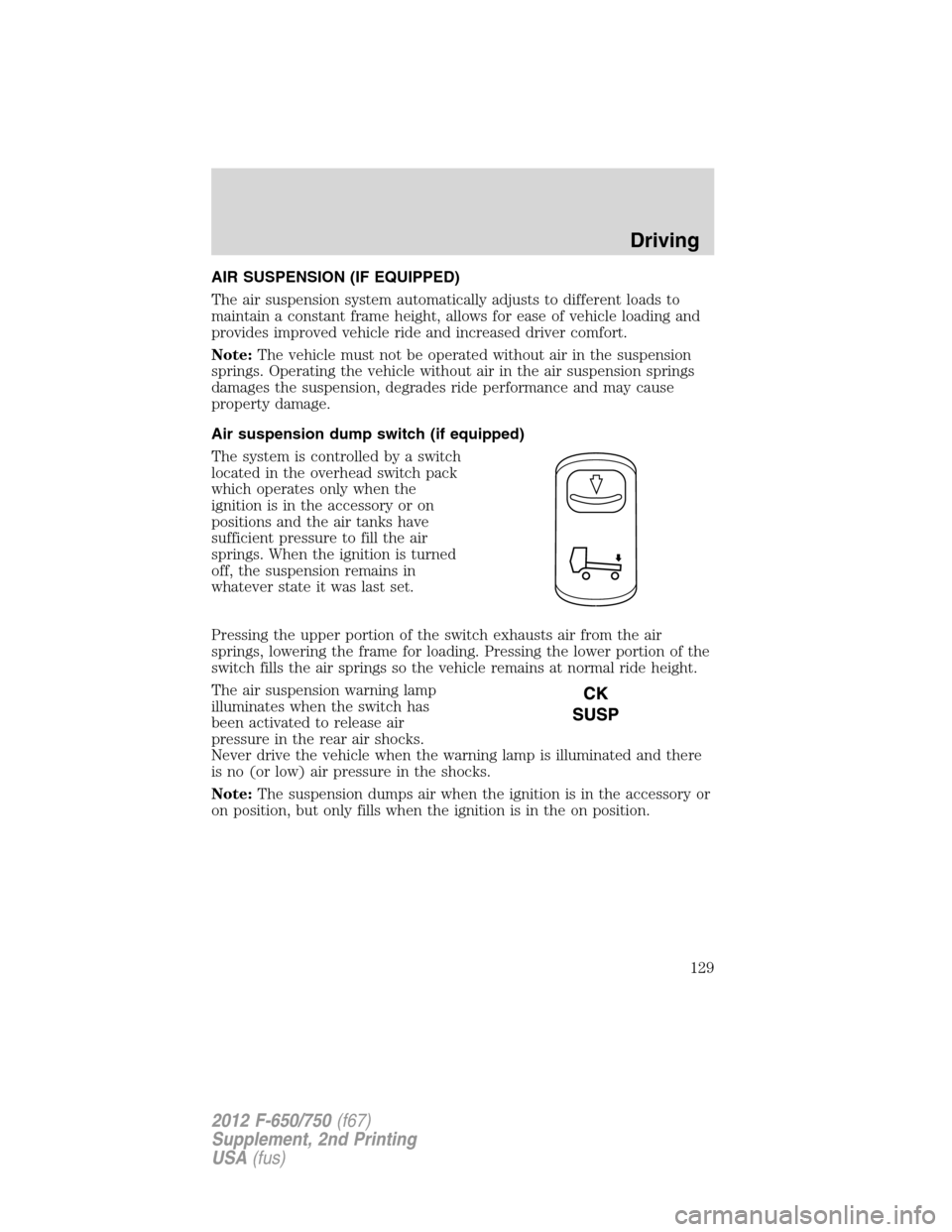
AIR SUSPENSION (IF EQUIPPED)
The air suspension system automatically adjusts to different loads to
maintain a constant frame height, allows for ease of vehicle loading and
provides improved vehicle ride and increased driver comfort.
Note:The vehicle must not be operated without air in the suspension
springs. Operating the vehicle without air in the air suspension springs
damages the suspension, degrades ride performance and may cause
property damage.
Air suspension dump switch (if equipped)
The system is controlled by a switch
located in the overhead switch pack
which operates only when the
ignition is in the accessory or on
positions and the air tanks have
sufficient pressure to fill the air
springs. When the ignition is turned
off, the suspension remains in
whatever state it was last set.
Pressing the upper portion of the switch exhausts air from the air
springs, lowering the frame for loading. Pressing the lower portion of the
switch fills the air springs so the vehicle remains at normal ride height.
The air suspension warning lamp
illuminates when the switch has
been activated to release air
pressure in the rear air shocks.
Never drive the vehicle when the warning lamp is illuminated and there
is no (or low) air pressure in the shocks.
Note:The suspension dumps air when the ignition is in the accessory or
on position, but only fills when the ignition is in the on position.
Driving
129
2012 F-650/750(f67)
Supplement, 2nd Printing
USA(fus)
Page 130 of 306
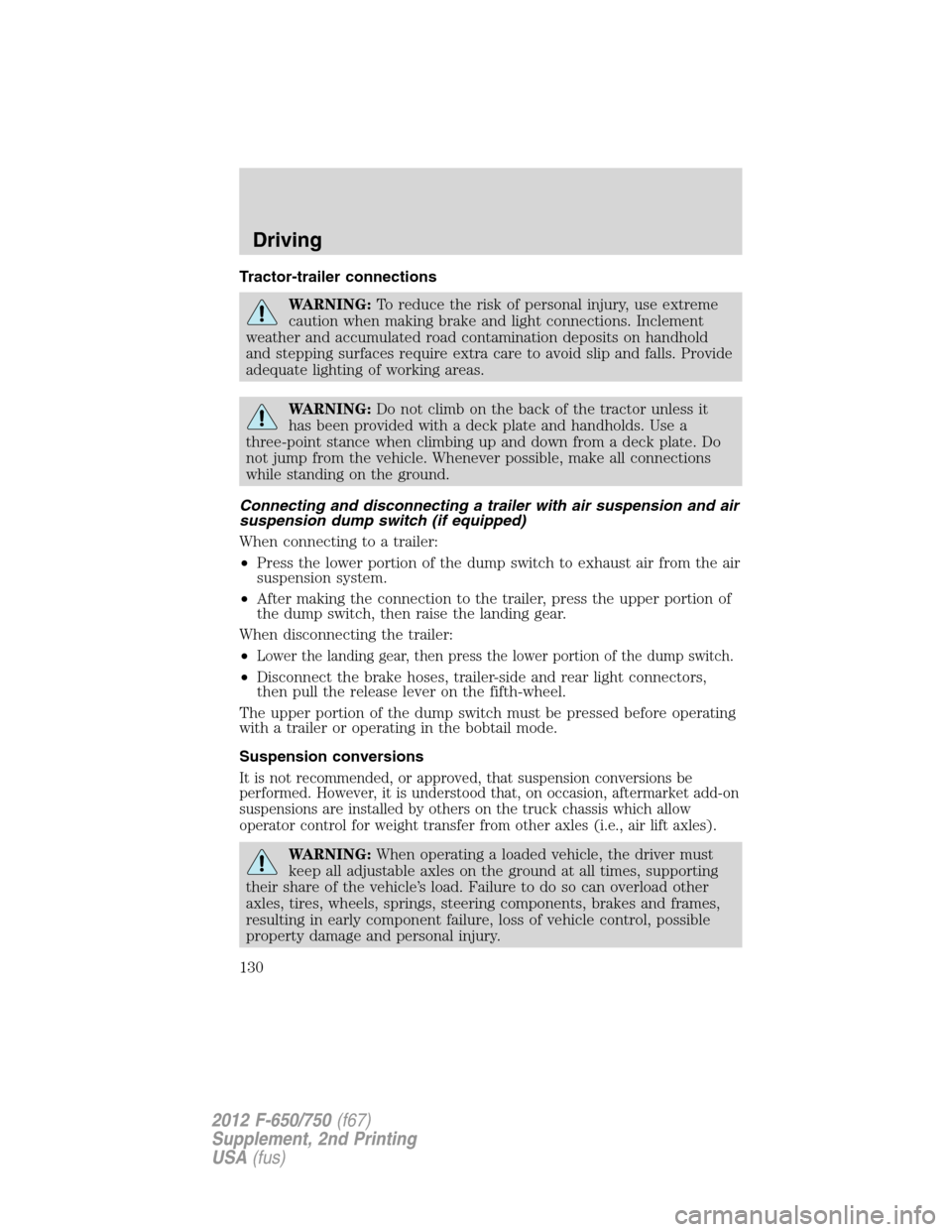
Tractor-trailer connections
WARNING:To reduce the risk of personal injury, use extreme
caution when making brake and light connections. Inclement
weather and accumulated road contamination deposits on handhold
and stepping surfaces require extra care to avoid slip and falls. Provide
adequate lighting of working areas.
WARNING:Do not climb on the back of the tractor unless it
has been provided with a deck plate and handholds. Use a
three-point stance when climbing up and down from a deck plate. Do
not jump from the vehicle. Whenever possible, make all connections
while standing on the ground.
Connecting and disconnecting a trailer with air suspension and air
suspension dump switch (if equipped)
When connecting to a trailer:
•Press the lower portion of the dump switch to exhaust air from the air
suspension system.
•After making the connection to the trailer, press the upper portion of
the dump switch, then raise the landing gear.
When disconnecting the trailer:
•
Lower the landing gear, then press the lower portion of the dump switch.
•Disconnect the brake hoses, trailer-side and rear light connectors,
then pull the release lever on the fifth-wheel.
The upper portion of the dump switch must be pressed before operating
with a trailer or operating in the bobtail mode.
Suspension conversions
It is not recommended, or approved, that suspension conversions be
performed. However, it is understood that, on occasion, aftermarket add-on
suspensions are installed by others on the truck chassis which allow
operator control for weight transfer from other axles (i.e., air lift axles).
WARNING:When operating a loaded vehicle, the driver must
keep all adjustable axles on the ground at all times, supporting
their share of the vehicle’s load. Failure to do so can overload other
axles, tires, wheels, springs, steering components, brakes and frames,
resulting in early component failure, loss of vehicle control, possible
property damage and personal injury.
Driving
130
2012 F-650/750(f67)
Supplement, 2nd Printing
USA(fus)